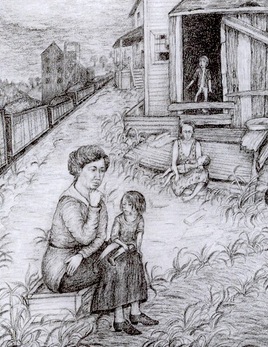|
J. William T. "Bill" Youngs, American Realities, Volume Two:
Historical Episodes from Reconstruction to the Present, Chapter Nine |
"Franklin D. Roosevelt and Eleanor Roosevelt" courtesy of the Wikipedia Commons
|
09. The New Deal
|
SummaryThis essay begins by showing Eleanor Roosevelt at the inauguration in 1933 of Franklin Delano Roosevelt as president. The moment serves as a point of departure for exploring Eleanor’s tragic childhood, her marriage to Franklin, and her emergence during the 1920s as a leading public figure. The essay then moves ahead to her role as first lady, where she becomes an advocate for the victims of prejudice and poverty-her “politics of compassion.” The last section traces her activities as a widow, especially her contribution to the Universal Declaration of Human Rights.
|
Author reads from the Text
As significant as Franklin Roosevelt’s achievement was, Eleanor Roosevelt’s career was just as distinctive. She redefined the role of first lady and, arguably, she set a standard that has not been matched in the half century since she left the White House. During her dozen years in Washington, Eleanor Roosevelt shook more hands, gave more teas, and attended more public functions than any other first lady before or since. These social activities were the sort of thing that presidents’ wives were expected to do. More importantly, Eleanor Roosevelt devoted her time to dozens of activities that went well beyond the traditional sphere. She wrote newspaper columns, delivered hundreds of speeches, and served as an advocate for various causes. One of Eleanor Roosevelt’s many nicknames was “America’s public energy no. 1.” A popular New Yorker cartoon in the 1930s showed two miners deep in the bowels of the earth, looking at an approaching figure. One miner was saying to the other, “Oh, my God, it’s Mrs. Roosevelt!” Just as her uncle, Theodore Roosevelt, recognized that the presidency is a “bully pulpit,” Eleanor Roosevelt demonstrated that the position of presidential spouse provided opportunities for promoting the public good.
Her energy allowed Eleanor Roosevelt to make contact with thousands of people: out-of-work coal miners, impoverished sharecroppers, and wounded soldiers. She seemed to be perpetually in motion, but at the same time she could immerse herself in each new moment as if nothing else mattered. Greeting the one-hundredth guest at a reception, she could make the person standing in front of her sense that he or she was the most interesting person in the room. Leaning over the bed of the fiftieth soldier in a hospital ward, she could manage to make that patient feel that he was uniquely important.
Her energy allowed Eleanor Roosevelt to make contact with thousands of people: out-of-work coal miners, impoverished sharecroppers, and wounded soldiers. She seemed to be perpetually in motion, but at the same time she could immerse herself in each new moment as if nothing else mattered. Greeting the one-hundredth guest at a reception, she could make the person standing in front of her sense that he or she was the most interesting person in the room. Leaning over the bed of the fiftieth soldier in a hospital ward, she could manage to make that patient feel that he was uniquely important.

